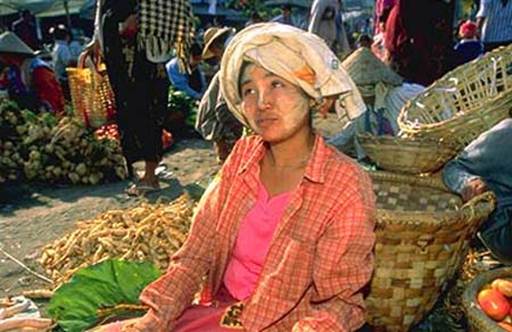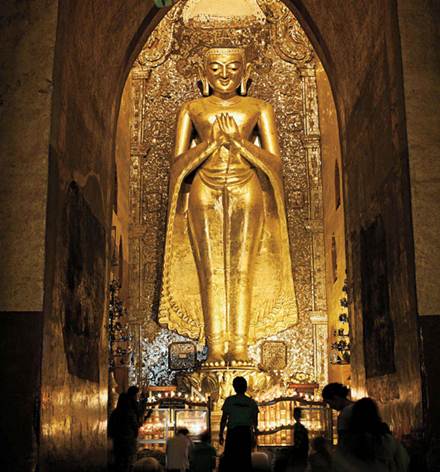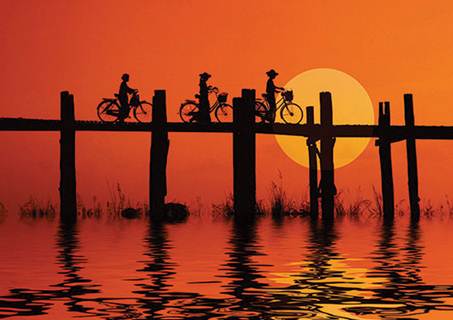As in other parts of Burma, visitors are
welcome at the local pagodas and monasteries. Indeed, part of the charm of any
trip to the country is the inclusiveness of the form of Buddhism practiced
there and the fact that today you often join happy groups of Burmese travelling
to these religious sites from far afield – such freedom of movement being a far
cry from my previous experiences of Burma. Jostling cheerfully among crowds of
elegant longboats, we felt as if we had strayed into an exotic Canaletto painting
as we moored by Phaung Daw Oo Pagoda. A long with the flotilla of an extended
Burmese family, we moved on to Nga Hpe Monastery. The ingenious monks at this
beautiful, wood-carved complex have managed to teach their resident cats to
jump through hoops on command; the third generation of such felines is now in
training, I was told. We jointed another large group of Burmese tourists
applauding a bizarre display by a couple of fat and otherwise snoozy tabbies,
their show resonating with the gently wacky character of the Intha people.

Burmese woman with thanaka on her face
Early the next day, our boat took us down
narrow channels festooned with kingfishers to the village of Indein. We had
come to see the pagoda complex, and particularly an amazing host of half-ruined
outlying stupas. Invasive vegetation has added fantastical drama to their
crumbling romance, with banyan trees having taken root in the brickwork here
and there, while elsewhere creepers are making a march on finely worked 17th-century
stucco decoration. Feeling like Indiana Jones, we scrambled through the
undergrowth to see intricate murals, beautifully rendered archways of mythical
birds, and even, inside one stupa, a golden Buddha sitting in rubble. Catch it
all while you can, said out guide. The Indein complex certainly needs rescuing,
but the worry is that conservation will be swept aside by development. Inle
Lake, he added, is changing very fast – thanks to tourism.

A
hot-air balloon over the area; the village surrounding Shinpin Shwe Gu Gyi
Pagoda; a young monk in Bagaya Monastery, Inwa; 86th Street Market,
Mandalay
We flew on to Mandalay that evening and
were staggered by the size of its airport, constructed in the late 1990s. Only
about a third of the vast arrivals hall was in use. Clearly it was built with
millions more visitors in mind.
Mandalay was the last capital of the
Burmese kings before the British took full control of the country in 1885. In
my youth it was a dusty place of house-drawn carts, low-level industry and many
monasteries. Thanks to Chinese investment, today it is booming. Yet it remains
a low-rise city and retains a village-like atmosphere. As a manifestation of
modern Burma, it is an absorbing place to visit because it is so go-ahead yet
so traditional. We wandered through the huge and buzzing market; we called in
at a couple of jade shops where great wads of money were changing hands between
Chinese traders; we visited a gold-leaf manufacture. Mandalay is the country’s
major centre for gold-leaf production. The wafer-thin strips of precious metal
are pounded by hand entirely to serve the religious needs of an ever-demanding
domestic market.

A
Buddha statue inside Ananda Temple in Bagan
As Mandalay’s 19th-century
palace was severely bombed during World War II, large sights are limited.
Tourists are taken to the carved-teak Golden Palace Monastery (Shwenandaw), the
only surviving building of the royal complex; to the serene Kuthodaw Pagoda,
where 729 huge marble slabs are inscribed with the text of the Tripitaka, the sacred
scripts of Theravada Buddhism; to the Mahamuni Pagoda, where one of Burma’s
most venerated Buddha images is housed – it is 3.8 metres high and so coated in
gold leaf that its body shape is becoming a blod. And perhaps the most famous
sight is 240-metre Mandalay Hill, where visitors climb covered stairways lined
with stalls and iconic images, timing their trip to the top to coincide with
sunset over the city and the great Irrawaddy River.

the
top to coincide with sunset over the city and the great Irrawaddy River